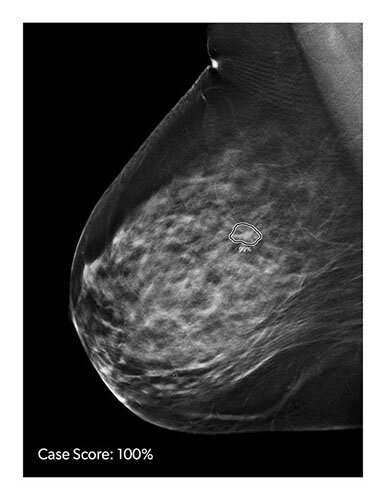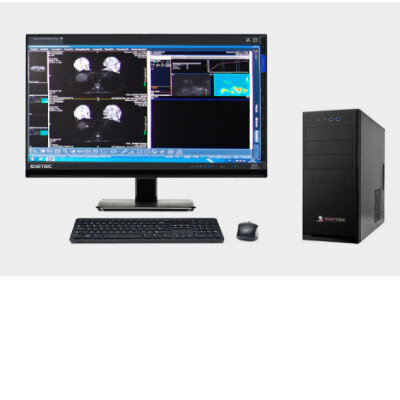Diffusion-Based MRI May Predict Dementia Advent
|
By MedImaging International staff writers Posted on 24 Oct 2019 |

Image: DSEG images of the reference brain (L), a stable SVD patient (C), and a patient who developed dementia (R) (Photo courtesy of Rebecca Charlton/ Goldsmith University of London).
An automatic diffusion tensor image segmentation (DSEG) technique could help assess brain microstructural damage in cerebral small vessel disease (SVD) patients, claims a new study.
Researchers at St George's University of London (SGUL; United Kingdom), Goldsmiths University of London (United Kingdom), and other institutions conducted a study involving 96 SVD patients (aged 43–89 years) in order to explore the extent to which DSEG, which characterizes microstructural damage using just a single diffusion tensor image (DTI) acquisition at 1.5T, can predict both degree of cognitive decline and conversion to dementia. All patients underwent annual MRI scanning for a period of three years and cognitive assessment for a five-year period. DSEG was used to map the cerebrum into 16 segments.
By comparing segments of an individual with SVD to those of a healthy brain, the researchers derived a DSEG spectrum containing information about grey matter, white matter, cerebrospinal fluid (CSF), and regions with diffusion profiles that deviate from those of healthy tissue. They found that DSEG measures increased over time, indicating progression of SVD burden, and that the DSEG measures also predicted decline in executive function and global cognition, as well as identifying stable individuals versus those who developed dementia.
In all, the results revealed that DSEG was significantly related to decline in executive function and global cognition, with 18.2% of the patients converted to dementia. Baseline DSEG predicted dementia with a balanced classification rate of 76%. No relationship was found between DSEG measures and information processing speed; the researchers suggest that perhaps this is because DSEG covers the entire cerebrum and not just white matter tracts, within which information processing and SVD are strongly associated. The study was published on September 12, 2019, in Stroke.
“Our objective was to find a measure of brain tissue microstructural damage. Using a new technique based on readily available MRI scans, we can predict which people go on to show cognitive decline and develop dementia,” said senior author Rebecca Charlton of Goldsmiths University of London. “In the future, DSEG technology could be used as a decision support system for clinicians. This technique has the potential to identify those patients at risk for cognitive decline and vascular dementia.”
Water molecules undergo random Brownian motion, also known as diffusion. MRI is sensitive to this motion, as controlled by the b-value. When the b-value equals zero, the images are not weighted by diffusion; when the b-value is greater than zero the images are diffusion-weighted. When cellular membranes, the myelin shield, etc., hinder the diffusion, the signal is higher. DTI can thus be used to visualize fiber structures, as it can readily differentiate water molecule diffusivities both along and against the fiber.
Related Links:
St George's University of London
Goldsmiths University of London
Researchers at St George's University of London (SGUL; United Kingdom), Goldsmiths University of London (United Kingdom), and other institutions conducted a study involving 96 SVD patients (aged 43–89 years) in order to explore the extent to which DSEG, which characterizes microstructural damage using just a single diffusion tensor image (DTI) acquisition at 1.5T, can predict both degree of cognitive decline and conversion to dementia. All patients underwent annual MRI scanning for a period of three years and cognitive assessment for a five-year period. DSEG was used to map the cerebrum into 16 segments.
By comparing segments of an individual with SVD to those of a healthy brain, the researchers derived a DSEG spectrum containing information about grey matter, white matter, cerebrospinal fluid (CSF), and regions with diffusion profiles that deviate from those of healthy tissue. They found that DSEG measures increased over time, indicating progression of SVD burden, and that the DSEG measures also predicted decline in executive function and global cognition, as well as identifying stable individuals versus those who developed dementia.
In all, the results revealed that DSEG was significantly related to decline in executive function and global cognition, with 18.2% of the patients converted to dementia. Baseline DSEG predicted dementia with a balanced classification rate of 76%. No relationship was found between DSEG measures and information processing speed; the researchers suggest that perhaps this is because DSEG covers the entire cerebrum and not just white matter tracts, within which information processing and SVD are strongly associated. The study was published on September 12, 2019, in Stroke.
“Our objective was to find a measure of brain tissue microstructural damage. Using a new technique based on readily available MRI scans, we can predict which people go on to show cognitive decline and develop dementia,” said senior author Rebecca Charlton of Goldsmiths University of London. “In the future, DSEG technology could be used as a decision support system for clinicians. This technique has the potential to identify those patients at risk for cognitive decline and vascular dementia.”
Water molecules undergo random Brownian motion, also known as diffusion. MRI is sensitive to this motion, as controlled by the b-value. When the b-value equals zero, the images are not weighted by diffusion; when the b-value is greater than zero the images are diffusion-weighted. When cellular membranes, the myelin shield, etc., hinder the diffusion, the signal is higher. DTI can thus be used to visualize fiber structures, as it can readily differentiate water molecule diffusivities both along and against the fiber.
Related Links:
St George's University of London
Goldsmiths University of London
Latest MRI News
- PET/MRI Improves Diagnostic Accuracy for Prostate Cancer Patients
- Next Generation MR-Guided Focused Ultrasound Ushers In Future of Incisionless Neurosurgery
- Two-Part MRI Scan Detects Prostate Cancer More Quickly without Compromising Diagnostic Quality
- World’s Most Powerful MRI Machine Images Living Brain with Unrivaled Clarity
- New Whole-Body Imaging Technology Makes It Possible to View Inflammation on MRI Scan
- Combining Prostate MRI with Blood Test Can Avoid Unnecessary Prostate Biopsies
- New Treatment Combines MRI and Ultrasound to Control Prostate Cancer without Serious Side Effects
- MRI Improves Diagnosis and Treatment of Prostate Cancer
- Combined PET-MRI Scan Improves Treatment for Early Breast Cancer Patients
- 4D MRI Could Improve Clinical Assessment of Heart Blood Flow Abnormalities
- MRI-Guided Focused Ultrasound Therapy Shows Promise in Treating Prostate Cancer
- AI-Based MRI Tool Outperforms Current Brain Tumor Diagnosis Methods
- DW-MRI Lights up Small Ovarian Lesions like Light Bulbs
- Abbreviated Breast MRI Effective for High-Risk Screening without Compromising Diagnostic Accuracy
- New MRI Method Detects Alzheimer’s Earlier in People without Clinical Signs
- MRI Monitoring Reduces Mortality in Women at High Risk of BRCA1 Breast Cancer
Channels
Radiography
view channel
Novel Breast Imaging System Proves As Effective As Mammography
Breast cancer remains the most frequently diagnosed cancer among women. It is projected that one in eight women will be diagnosed with breast cancer during her lifetime, and one in 42 women who turn 50... Read more
AI Assistance Improves Breast-Cancer Screening by Reducing False Positives
Radiologists typically detect one case of cancer for every 200 mammograms reviewed. However, these evaluations often result in false positives, leading to unnecessary patient recalls for additional testing,... Read moreUltrasound
view channel
Deep Learning Advances Super-Resolution Ultrasound Imaging
Ultrasound localization microscopy (ULM) is an advanced imaging technique that offers high-resolution visualization of microvascular structures. It employs microbubbles, FDA-approved contrast agents, injected... Read more
Novel Ultrasound-Launched Targeted Nanoparticle Eliminates Biofilm and Bacterial Infection
Biofilms, formed by bacteria aggregating into dense communities for protection against harsh environmental conditions, are a significant contributor to various infectious diseases. Biofilms frequently... Read moreNuclear Medicine
view channel
New SPECT/CT Technique Could Change Imaging Practices and Increase Patient Access
The development of lead-212 (212Pb)-PSMA–based targeted alpha therapy (TAT) is garnering significant interest in treating patients with metastatic castration-resistant prostate cancer. The imaging of 212Pb,... Read moreNew Radiotheranostic System Detects and Treats Ovarian Cancer Noninvasively
Ovarian cancer is the most lethal gynecological cancer, with less than a 30% five-year survival rate for those diagnosed in late stages. Despite surgery and platinum-based chemotherapy being the standard... Read more
AI System Automatically and Reliably Detects Cardiac Amyloidosis Using Scintigraphy Imaging
Cardiac amyloidosis, a condition characterized by the buildup of abnormal protein deposits (amyloids) in the heart muscle, severely affects heart function and can lead to heart failure or death without... Read moreGeneral/Advanced Imaging
view channel
New AI Method Captures Uncertainty in Medical Images
In the field of biomedicine, segmentation is the process of annotating pixels from an important structure in medical images, such as organs or cells. Artificial Intelligence (AI) models are utilized to... Read more.jpg)
CT Coronary Angiography Reduces Need for Invasive Tests to Diagnose Coronary Artery Disease
Coronary artery disease (CAD), one of the leading causes of death worldwide, involves the narrowing of coronary arteries due to atherosclerosis, resulting in insufficient blood flow to the heart muscle.... Read more
Novel Blood Test Could Reduce Need for PET Imaging of Patients with Alzheimer’s
Alzheimer's disease (AD), a condition marked by cognitive decline and the presence of beta-amyloid (Aβ) plaques and neurofibrillary tangles in the brain, poses diagnostic challenges. Amyloid positron emission... Read more.jpg)
CT-Based Deep Learning Algorithm Accurately Differentiates Benign From Malignant Vertebral Fractures
The rise in the aging population is expected to result in a corresponding increase in the prevalence of vertebral fractures which can cause back pain or neurologic compromise, leading to impaired function... Read moreImaging IT
view channel
New Google Cloud Medical Imaging Suite Makes Imaging Healthcare Data More Accessible
Medical imaging is a critical tool used to diagnose patients, and there are billions of medical images scanned globally each year. Imaging data accounts for about 90% of all healthcare data1 and, until... Read more
Global AI in Medical Diagnostics Market to Be Driven by Demand for Image Recognition in Radiology
The global artificial intelligence (AI) in medical diagnostics market is expanding with early disease detection being one of its key applications and image recognition becoming a compelling consumer proposition... Read moreIndustry News
view channel
Bayer and Google Partner on New AI Product for Radiologists
Medical imaging data comprises around 90% of all healthcare data, and it is a highly complex and rich clinical data modality and serves as a vital tool for diagnosing patients. Each year, billions of medical... Read more




















